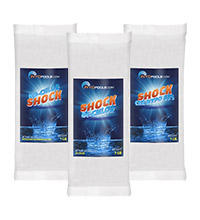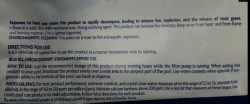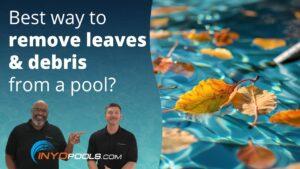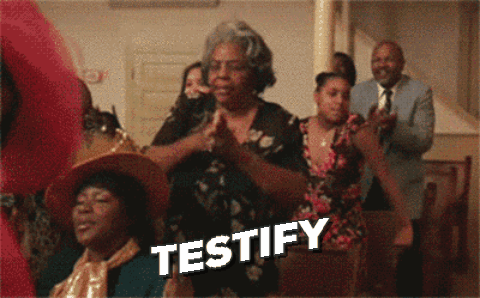Shocking your pool, or super chlorinating, is a cleaning method designed to keep your pool water clean and safe by adding three to five times the normal amount of chlorine. This drastically raises the chlorine level in a short period of time. Shocking your pool should not be a daily routine. Sure, there are times when shocking your pool is absolutely necessary like the times when you neglect your pool or when your pool is recovering from a terrible storm. However, if you have a salt water generator and consistently test and monitor your chemical levels, there shouldn’t be a need to shock your pool often.
Pool owners usually have a single concern when shocking their pool- How long after I shock my pool can I swim?
Unfortunately, there is no general consensus within the pool community when it comes to determining how long you should wait before swimming again. However, even with no general consensus, we were still able to discover many convincing factors that helped narrow down when the pool is safe for swimmers again after shocking. (If’ you’re a skim reader and just looking for the answer, read the last paragraph.)
How Dirty Is Your Pool?
Generally speaking, most balancing chemicals,(such as pH, alkalinity, and calcium hardness) become part of your pool water within an hour or so after adding them, at which time, you should be able to swim. Shocking, on the other hand, takes longer to adjust the pool. As a result, there has to be a longer waiting period before it is safe for swimming. But exactly how long must one wait before the water is safe for swimming? There are usually factors you need to consider before giving your swimmers a realistic time frame before jumping in.
First, assess how bad or dirty your pool actually is. Obviously, pools that are days away from becoming a swamp require more time and maintenance than a pool recovering from a rainy day. And swimming pools that require an extensive treatment due to algal blooms are in a class of their own. It can literally take weeks. On average, pool owners use three to five times the normal dosage when shocking. However, during serious conditions, some pools may need five to ten times the normal dosage.
The purpose for such a large dose is to break down the combined chlorine, organic waste, and other contaminants in your pool and re-establish a positive level of free chlorine. This process is not instant and can take several days to conquer. The condition and the chemical levels in every pool vary. That is why it is impossible for a pool technician to hand out specific time frames that are suitable for EVERY pool.
What Kind of Shock Are You Using?
The type of shock you use to shock your pool also affects how long you have to wait until you jump back into the pool. The two most popular shocks we encounter at INYO  are shocks with chlorine and shocks without chlorine. Shocks with chlorine, or cal-hypo, make up the majority of chlorine- based shock available today. The major differences lie in the concentration levels of the active ingredients. Most shocks with chlorine take longer to interact with your pool than non-chlorine shock.
are shocks with chlorine and shocks without chlorine. Shocks with chlorine, or cal-hypo, make up the majority of chlorine- based shock available today. The major differences lie in the concentration levels of the active ingredients. Most shocks with chlorine take longer to interact with your pool than non-chlorine shock.
Chlorine- free shock oxidizes bacteria and organics in your pool without any additional chemicals. With this type of shock, you can swim in the pool just one hour after. Chlorine- based shock contains high levels of pH and will alter both your pH and chlorine levels in the pool. Chlorine- free shock has a neutral pH and will not affect any of your other chemical levels.
It’s a general precaution to monitor the type of chemicals you are putting into your pool. As you can see, even the type of shock you use can affect other chemicals that are already in your pool. And in turn, it will delay your swimmers from returning to the pool.
How Long Should I Wait… Exactly?
I’ve written a couple of paragraphs so far but haven’t actually answered the question at hand, how long after shocking your pool do you have to wait until you swim again? Technically, if your free chlorine levels are holding up, swimming UP TO your shock level, depending on your CYA, is safe. Keep in mind, no one should swim in a cloudy pool, even if your free chlorine levels are holding. If the water clarity prevents you from seeing the bottom of the pool, we recommend you do not return back to the pool. From a security standpoint, it prevents you from watching for submerged children.
Another good rule of thumb is to follow the manufacturer’s instructions on the back of the product. Typically on all chemicals, the manufacturer provides directions for use, precaution warnings, and tips for storage and disposal. The back the bag of shock we analyzed states, “Follow label directions for each product. Re-entry into treated pools is prohibited above 4 ppm.” The manufacturer’s caveat runs parallel with swimming up to your shock level.
In short, if you want to be certain that your water is safe before returning to swim, test it. Once your free chlorine levels are holding and you can see the bottom of your pool, you can safely return swimming up to your shock levels for your CYA. Secondly, review the instructions on the back of your shock. Most companies provide the levels they recommend swimmers are safe to return back to the pool.
















Leave a Reply